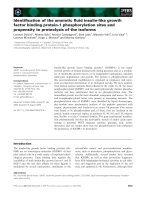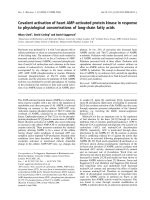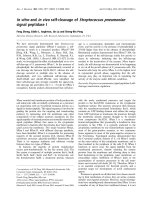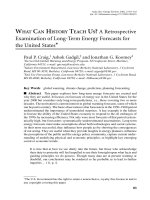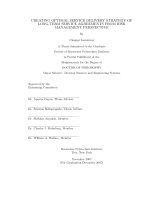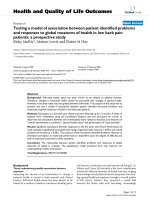Pyrolysis and propensity to self ignition of long term low temperature wood chars
Bạn đang xem bản rút gọn của tài liệu. Xem và tải ngay bản đầy đủ của tài liệu tại đây (9.04 MB, 106 trang )
PYROLYSIS AND PROPENSITY TO SELF IGNITION OF
LONG-TERM LOW-TEMPERATURE WOOD CHARS
HOANG NGOC QUYNH AN
NATIONAL UNIVERSITY OF SINGAPORE
2009
PYROLYSIS AND PROPENSITY TO SELF IGNITION OF
LONG-TERM LOW-TEMPERATURE
WOOD CHARS
HOANG NGOC QUYNH AN
B. Sc (Bldg) (Hons), NUS
A THESIS SUBMITTED
FOR THE DEGREE MASTER OF SCIENCE
DEPARTMENT OF BUILDING
SCHOOL OF DESIGN AND ENVIRONMENT
NATIONAL UNIVERSITY OF SINGAPORE
2009
ii
ACKNOWLEGEMENTS
I would like to express my sincere gratitude to my supervisor, Professor Michael
Chew Yit Lin, for his continuous support, encouragement and guidance throughout the
course of study and research.
I am also grateful to Mr Tan Seng Tee, Mr Zaini Bin Wahid, Mr Arumugam
Gunaseigaran and other staffs from Fire Laboratory and other laboratories in the
Department of Building, Mdm Leng Lee Eng and Ms Tan Tsze Yin from Elemental
Analysis Laboratory, Mr Lee Yoon Kuang from Organic Laboratory and other
technician staffs in the Department of Chemistry for their kind assistance and constant
cooperation.
I also wish to show my deep appreciation to Mr Ng Tong Hai from Chong Sun
Wood Products Pte Ltd for his kind-hearted and generous sponsor of wood specimens.
I want to thank my friends from Bukit Batok house and NUS, Anh, Huong,
Loan, An, Nguyen, Nhan and Ha, for all the fun and precious entertaining moments.
Finally, I would like give my special thanks to my family for their unflagging
love, care, encouragement and support, this thesis is simply impossible without them.
iii
TABLE OF CONTENTS
Title page
Acknowledgements
ii
Table of Contents
iii
Summary
vi
List of Tables
vii
List of Figures
viii
Chapter 1
Chapter 2
Introduction
1-5
1.1.Background
1
1.2.Research problems and objectives
2
1.3.Organisation of the study
4
Literature review
6-22
2.1.Introduction
6
2.2.Self ignition
6
2.2.1.Self ignition and gas-phase ignition
6
2.2.2.Self ignition of wood materials
7
2.2.3.Self ignition in limited oxygen
conditions
11
2.3.Pyrolysis of wood at low temperatures
13
2.4.Functional groups and char reactivity
17
2.5.Oxygen chemisorption
19
2.5.1.Oxygen chemisorptions and char reactivity
19
iv
2.5.2.Elovich equation
Chapter 3
2.6.Concluding remarks
22
Research methodology
23-34
3.1.Introduction
23
3.2.Selection of materials
23
3.3.Pyrolysis experiments
24
3.3.1.Heat treatment in atmospheric condition
25
3.3.2.Heat treatment in vacuum condition
26
3.4.FTIR
28
3.4.1.Basic principles
28
3.4.2.Experimental procedures
29
3.5.TGA
31
3.4.1.Basic principles
31
3.4.2.Experimental procedures
32
3.6. Concluding remarks
Chapter 4
20
Pyrolysis of Wood
34
35-53
4.1.Introduction
35
4.2.Descriptions of preheated wood chars
35
4.3.Elemental analysis
42
4.4.Kinetics of pyrolysis of wood specimens in air
44
4.5. Concluding remarks
53
v
Chapter 5
Chapter 6
Characterization of wood chars
54-70
5.1.Introduction
54
5.2.Infrared spectroscopic analysis
54
5.2.1.Kapor wood char
54
5.2.2.Nyatoh wood char
59
5.2.3.Comparison of wood chars before and after
chemisorption
60
5.3.Oxygen chemisorption of wood chars
61
5.4.Concluding remarks
70
Conclusions and Recommendations
71-77
6.1.Conclusions
71
6.2.Recommendations for future works
76
Bibliography
78-82
Appendices
83-94
vi
SUMMARY
Cases have shown that when wood was exposed to long-term low temperature heat
sources with different oxygen exposure conditions; it turned into reactive chars that
carried fire risk. However, there is still little experimental data explaining the
pyrolysis process and reactivity of these chars.
This thesis provided a
comprehensive study with experimental evidences on the pyrolysis and propensity
to self ignition of long-term low-temperature wood chars.
Pyrolysis experiments were carried out on Kapur and Nyatoh hardwood species in
ovens isothermally at low temperatures 160 °C, 175 °C and 190 °C for extended
durations up to 153 days in both anaerobic and aerobic conditions. Empirical
pyrolysis kinetic models of Nyatoh and Kapor wood under isothermal conditions in
air were developed based on weight loss history of the pyrolysis process. Thermogravimetric analysis (TGA) and Fourier Transform Infrared spectroscopy (FTIR)
were employed as analytical methods to determine the oxygen chemisorption and
functionality of these chars.
It was shown that except for the initial fast degradation, the wood degraded
following a first order reaction process. The activation energies of the two kinds of
hardwood used in this study were different although these values were still in the
range reported in literature. The difference could be explained by the different
chemical composition with different proportion of cellulose, hemicelluloses and
lignin presenting in each wood specie.
Chars created at low temperature for long duration in both aerobic and anaerobic
conditions were proved to be reactive and susceptible to oxygen chemisorptions.
These chars carried the potential of self ignition. Under the same exposure
vii
conditions, anaerobic wood char had higher initial rate of oxygen chemisorptions,
in other words, it is evidenced that anaerobic chars are more reactive. Through
FTIR investigation, anaerobic chars had more reactive aliphatic groups, especially
aliphatic α-CH2. For less reactive aerobic char, it was believed that benzylic and
hydroaromatic groups were the reactive sites responsible for the oxygen
chemisorption.
The reactivity of the chars increased with the degree of pyrolysis, the char reactivity
would reach the highest at charcoal condition with the final weight around 19-25%.
The pyrolysis kinetic model could be used to obtain the rough estimate of the
heating period to reach different degrees of degradation under air condition as a
function of temperature of Nyatoh and Kapor wood.
The theoretical understanding had practical meaning to the extensive use of wood
in related to fire safety and fire protection.
The results of the thesis have been published in the following conferences and
journal:
1. N. Q. A. Hoang and M. Y. L. Chew, "Experimental findings on char
characterization of pyrophoric chars," in 7th Asia-Oceania Symposium on Fire
Science and Technology Hong Kong, 2007. (Poster presentation)
2. N. Q. A. Hoang and M. Y. L. Chew, "Propensity of low-temperature and
anaerobic and aerobic wood chars to self ignition " in Fire and Material
Conference 2009 San Francisco, 2009. (Conference article)
3. N. Q. A. Hoang and M. Y. L. Chew, "Pyrolysis of tropical hardwood under
long-term and low-temperature conditions," Construction and Building
Materials, 2009. (in proceeding)
vii
LIST OF TABLES
Number
Title
Page
2.1
Loss in weight and transverse shrinkage of hard maple
specimens during oven heating (Reprinted from
McNaughton, "Ignition and Charring temperatures of wood,"
Forest Products Laboratory1944)
15
3.1
Heat treatment conditions and weight loss of wood char
specimens
27
4.1
Description of Kapor wood specimens after heat treatment at
160°C and 175°C in air
37
4.2
Description of Nyatoh wood specimens after heat treatment
at 175°C in air
40
4.3
Elemental analysis of Kapor wood chars after heat treatment
at 160 °C and 175 °C
42
4.4
Values of final weight residue and constant k when heating
wood specimens at low temperatures
49
5.1
Elovich constants for oxygen chemisorption on wood chars
preheated at 175°C in air and in inert conditions
65
5.2
Comparison of quantity of oxygen chemisorption and initial
chemisorption rate between present study and other studies in
literature
69
viii
LIST OF FIGURES
Number
Title
Page
2.1
An 89 mm wood cube after self-heating at 200 °C (Reprinted
from B. R. Cuzzillo, "Pyrophoria," in Mechanical
Engineering, Doctor of Philosophy Berkeley: University of
California, 1997, p. 182)
10
2.2
Hourglass heat pattern of a 89 mm wood cube split along
longitudinal grain after self-heating (Reprinted from B. R.
Cuzzillo, "Pyrophoria," in Mechanical Engineering, Doctor of
Philosophy Berkeley: University of California, 1997, p. 182)
10
2.3
200mm wood cube after9 days at 200 °C with the end-grain
faces sealed with RTV (Reprinted from B. R. Cuzzillo,
"Pyrophoria," in Mechanical Engineering, Doctor of
Philosophy Berkeley: University of California, 1997, p. 182)
11
2.4
The time required to achieve a 40 % residual weight level for
oven-heated wood as a function of heating temperature
( Reprinted from E. L. Schaffer, "Smoldering Initiation in
Cellulosics under Prolonged Low-Level Heating," Fire
technology, vol. 16, pp. 22-28, 1980)
17
3.1
Fresh wood block size 1 ¼ x 1 ¼ x 4 inches
24
3.2
Cabolite oven
25
3.3
Wood specimens heated in Cabolite oven with access of air
26
3.4
Vacuum oven with vacuum pump
26
3.5
IR Prestige-21 Spectrometer
30
3.6
FTIR equipment: (a) hydraulic laboratory hand press to
produce pellet, (b) pellet of char powder and KBr, (c) pellet
held in plate for measurement inside the spectrometer
30
3.7
TGA apparatus SDT 2960
33
3.8
Aluminium sample pan holding wood char and empty
reference pan on balance beams of SDT 2960
33
ix
4.1
Wood specimens after heat treatment in vacuum for duration
of (a) untreated, (b) 12 days, (c) 26 days
41
4.2
Plots of percentage of elemental content in char residues
versus weight loss of Kapor wood specimens heated in air at
160°C and 175°C
43
4.3
Plots of percentage of residual weight of wood specimens
under isothermal heating in air: A- Kapor wood, B- Nyatoh
wood
45
4.4
Plots of ln ቀ
ௐିௐಮ
ௐబ
ቁ versus time of A-Kapor and B-Nyatoh
48
wood heated in air
4.5
Plots of ln ݇ versus reciprocals of absolute temperature of:
A-Kapor and B- Nyatoh wood
50
4.6
Plots of 1/T versus ln(t) of A-Kapor and B- Nyatoh wood
52
5.1
FTIR spectra of wood chars heated in vacuum at 175°C for
different duration
55
5.2
FTIR spectra of Kapor wood chars heated in air at 160°C for
different duration
57
5.3
FTIR spectra of Kapor wood chars heated in air at 175°C for
different duration
57
5.4
Comparison of FTIR spectra of wood char heated at 175°C for
12 days in air and vacuum condition
58
5.5
FTIR spectra of Nyatoh wood chars heated in air at 160°C for
different duration
59
5.6
FTIR spectra of wood chars heated in vacuum at 175°C for 26
days before chemisorptions and after chemisorptions in air at
50°C for 10 hours
60
5.7
Mass gain during chemisorption of oxygen at different
isothermal temperatures of Kapor wood char preheated at
175 °C for 26 days in vacuum
63
5.8
Mass gain during chemisorption of oxygen at different
isothermal temperatures of Kapor chars preheated at 175 °C
for 26 days in air
63
5.9
Mass gain during chemisorption of oxygen at different
isothermal temperatures of Kapor chars preheated at 175 °C
for 93 days in air
64
x
5.10
An Arrhenius plot of oxygen chemisorption of Kapor chars
preheated at 175 °C for 26 days in vacuum
67
5.11
An Arrhenius plot of oxygen chemisorption of Kapor chars
preheated at 175 °C for 26 days in air
67
5.12
An Arrhenius plot of oxygen chemisorption of Kapor chars
preheated at 175 °C for 93 days in air
68
CHAPTER 1 1
Introduction
CHAPTER 1
Introduction
1.1. Background
As trees covers most habitable area of the Earth, wood has become the most
familiar material to human being. In the past, wood was used extensively in house
building, working tools and ship making due to its durability and availability.
Nowadays, wood still plays an important role in everyday life. Hundreds of things
made from wood can be found anywhere like stationary (pencils, paper…),
accessories and furniture. Wood are still used as building components like beams,
posts, doors, windows, flooring, ceiling or wall lining. Wood is very useful to
human life; however, it is also known as a flammable material and carries fire risk.
Every year, in some countries like Australia and Indonesia, bushfires break out and
cause a lot of damage in hot and dry season. Wood materials easily catch fire and
make the fire more severe.
Usually, wood ignites when it is provided enough heat and oxygen. The
short-term ignition of wood requires the temperature to be raised to approximately
250°C [1]. In many other cases, the auto-ignition or spontaneous ignition
temperature of wood is reported as high as 600°C by radiation and 490°C by
conduction respectively [2]. Thus, in normal practice, little precautions have been
taken when wood is in proximity to much lower temperatures. However, some fire
incidents still happened due to the self ignition of wood at below 200°C and the
CHAPTER 1 2
Introduction
lowest ignition temperature was reported at 77°C [3]. These were the cases when
wood were in contact with low level heat sources like hot water pipes, hot operating
machines and hot air ducts. Ignition occurred after wood self heated at low
temperatures for a long period of time and built heat inside the material through
exothermic reactions. The duration may vary from 3 months to 15 years [3]
depending on many factors including exposure temperature and oxygen condition.
In average, air is comprised of 21 percent oxygen, however, in lower-concentrated
oxygen environment, self-heating can still happen when the surrounding
environment is at a relatively low temperature [4].
1.2. Research problems and objectives
The propensity of self ignition of wood material after being self heated for a
period of time has interested many researchers. McNaughton [5] carried out
experimental tests on the weight loss of small wood samples at low temperatures
for extended durations, however, the tests were restricted to only observations and
descriptions. Stamm [6] did more in-depth analysis on rate of thermal degradation,
yet, he only used the data of cellulose, cotton and some softwood species. Recently,
the studies of thermal degradation have been mainly conducted on chars created at
pretty high temperatures (above 300°C) for very short durations. There is still a
lack of research results for wood chars created at long-term low-temperature
conditions which are closed to self-heating situations in order to prevent and control
unwanted fire cases. This thesis provides the experimental study on long-term lowtemperature wood chars with the following goals:
CHAPTER 1 3
Introduction
1. To develop empirical pyrolysis kinetic model of hardwood chars heated
in air at low temperatures (below 200°C) based on weight loss during the
degradation process. Data were collected on different species of hardwood. The
study seeks to establish the rates of pyrolysis of different species of hardwood at
low temperatures and the reaction order that corresponds to these rates and thus
estimate the heating duration to reach different degrees of degradation as a function
of temperature.
2. To compare the chemisorption characteristics and reactivity of aerobic
and anaerobic wood chars and investigate their propensity to self ignition. The
reactivity of chars can be measured by the rate of chemisorption [6]. There are
many studies about the reactivity of carbon and cellulosic chars created at different
temperatures and oxygen conditions, however, little is known about the reactivity
of wood chars created under low temperature in both anaerobic and aerobic
conditions. It is not accurate to extrapolate the chemisorption data of carbon or
cellulosic chars to wood chars, this is because wood also contains hemicelluloses,
lignin and a small amount of inorganic constituents, other than cellulose. Thermogravimetric analysis (TGA) was employed to determine the chemisorption
characteristics of the chars. Rates of oxygen uptake and activation energies were
calculated using Elovich kinetics and Arrhenius equation to describe the types of
reactive sites presenting in the wood char.
3. To examine the chemical effects involved in pyrolysis and oxygen
chemisorption of wood chars. Fourier-transform infrared (FTIR) spectroscopy
was used as an analytical method to detect the changes in functional groups. It has
been pointed out that functional groups other than free radicals could play a major
CHAPTER 1 4
Introduction
role in determining the functionality and reactivity of the char [7]. In this study, the
development of functional groups in wood during pyrolysis process was
investigated. The functionality changes of wood chars when exposed to air during
oxygen chemisorption experiments provide the explanations for the bulk-scale
chemisorption behaviour and help to identify the reactive groups.
1.3. Organisation of the study
The study was organized as follows:
Chapter 1 described the background concerning the potential hazards to fire in
general and to self ignition in particular of wood materials. The background
provided the basis understanding on the usage of wood and the cases leading to self
ignition. The research problems and research objectives were indentified in
connection with the gaps identified in Chapter 2 of Literature Review.
Chapter 2 reviewed the literature. The chapter differentiated self ignition to gasphase ignition and evaluated the possibility of self heating and self ignition of wood
materials in different oxygen conditions. The pyrolysis process of wood and its
kinetics were discussed. The details of functionality and its effects on
chemisorption were described.
The chapter also highlighted the role of
chemisorption and discussed the application of Elovich kinetic model to oxygen
chemisorption of lignocellulosic materials.
Chapter 3 discussed the research methodology on wood pyrolysis and char
characterization. The chapter first described pyrolysis experiments with the careful
CHAPTER 1 5
Introduction
selection of materials. It then presented the two analytical methods to characterize
the pyrolyzed wood chars. This included the measurements of functional groups
using FTIR and the measurements of oxygen chemisorption using TGA.
Discussions of the principles of each technique and subsequent experimental
procedures were provided.
Chapter 4 presented the results of wood pyrolysis. The visible physical changes
including wood colour, shrinkage and cracks after heated in ovens at low
temperatures for extended durations were described in details. Besides, an attempt
was made to determine the kinetics of thermal degradation Nyatoh and Kapor wood
in air using the weight loss data throughout the degradation process.
Chapter 5 analyzed the characterization of wood chars based on FTIR and TGA
results. Functional group changes during heat treatments and oxygen chemisorption
were presented. The effects of oxygen chemisorption to the char functionality were
investigated to provide an insight to the changes in the chemical bonds attributed to
the oxygen chemisorption process. Besides, the differences in reactivity between
aerobic and anaerobic wood chars were examined.
Finally, Chapter 6 presented the research findings and recommendations for future
works.
CHAPTER 2 6
Literature Review
CHAPTER 2
LITERATURE REVIEW
2.1. Introduction
A great deal of previous studies existed in the research literature showed the self
ignition properties of lignocellulosic materials. The review of this study focused
primarily on the reports and research done on the pyrolysis and self-ignition of
solid wood members. Firstly, the chapter justified the fire hazards of wood material
due to self ignition. The remaining part of the chapter was sectioned according to
the three main scopes and objectives of the study including: pyrolysis of wood at
low temperatures, functionality of the wood chars and chemisorption characteristics
of these chars. The review provided in this chapter proved the need for this study.
2.2. Self ignition
2.2.1. Self ignition and gas-phase ignition
Self ignition and piloted or auto-ignition of wood have totally different mechanism.
To research on the propensity of self ignition, it is essential to distinguish between
self ignition and piloted or auto-ignition because the causes leading to piloted and
auto-ignition may not applicable to self ignition.
According to NFPA 921 Guide for Fire and Explosion Investigations [4], self
ignition arises from self heating which is the result of internal reactions and
processes producing sufficient heat under satisfactory conditions . In the concern of
this study, the reactions and processes involved are the exothermic chemical
CHAPTER 2 7
Literature Review
reactions including exothermic pyrolysis or surface oxidation reactions [8], as a
consequence self ignition can be called solid-phase ignition. Self ignition occurs at
relatively low temperatures (100 to 200 °C or even below) after a long period of
heat generation [9]. Self ignition is also called spontaneous ignition or spontaneous
combustion.
In case of normal ignition, a spark or flame helps to initiate the piloted ignition
process while auto-ignition occurs without any spark or flame source. Both piloted
ignition and auto –ignition have the same fashion of ignition: when subjected to the
high heat source, wood will give off combustible gases; these gaseous products are
then mixed with air and react with oxygen leading to ignition in the gas phase, so
they are also called gas-phase ignition [8].
2.2. 2. Self-heating of wood materials
Schwartz [10] stated in his book in 1901 that "...wood exhibits a certain weakness
that is not shared by iron or metal, namely, the tendency to ignite spontaneously
when exposed to the protracted influence of a source of small external heat”. In
1911, the Independent Inspection Bureau [11] reported more than a dozen of fires
started by low pressure steam pipes in a NFPA Quarterly volume 4. As in the
concern of this study, self-heating required the heat from exothermic pyrolysis or
surface oxidation reactions, the access of oxygen into the material helped to sustain
the oxidation reactions and pyrolysis process. Thus, porous forms of materials
obviously supported self-heating more than those in solid forms. The porous forms
of wood material included wood sawdust, wood fibreboard and wood chips and
solid forms included wood beams and wood posts. In historical record of self
ignition, many cases were reported on the self-heating of piles of porous haystacks
CHAPTER 2 8
Literature Review
[12] or charcoal. A fire breakout due to self-ignition of wood fibreboard during
storage and transport in 1950 was recorded by Mitchelle [13]. Before ignition, the
fibreboard was found to stack in one pile in the warehouse measuring more than
24,000 cubic feet when the surrounding air was at about 75 °F (24 °C).
Still, cases of self ignition of solid wood members have been reported in many
studies. Most of the cases originated from prolonged contact of wood members
with heat sources like hot steam pipes, hot water pipes and other hot surfaces in the
temperature range 100-170°C [8]. Schwartz [10] listed the possible circumstances
leading to self heating and outbreaks of fire which included: “a lamp hanging too
near a beam; a steam pipe or hot air pipe laid too close to woodwork; dust settling
down in thick layers on heated vessels or pipes; defective insulating material
around a steam pipe, stove, fireplace, drying plant, and more, which are thereby
enabled to radiate heat continuously against wooden articles”. He also found that
high temperatures were unnecessary but the prolonged exposure played as a crucial
factor. Bixel and Moore [14] reported self ignition of a wood beam due to hot steam
pipe drilled through it, the exposure time was from 3 months to 3 years prior to
ignition. The duration might be up to 15 years as reported by Matson et al. [15].
Nailen [16] also reported a fire case when wood joists were placed near a hot-water
radiator.
McGuire [17] suggested that generation of charcoal constituted a hazard associated
with subsequent self heating in the cases of fires arising from steam pipes. This was
in good agreement with Schaffer’s study [18], at a temperature range between
100 °C and about 280 °C, the wood underwent slow pyrolysis process
characterizing by losing weight slowly and turning into charcoal eventually. He
CHAPTER 2 9
Literature Review
also stated that the formation of charcoal in the thermal degradation was a
significant factor in self-heating process and initiation of flaming combustion.
Shafizadeh and Bradbury [19] found that cellulosic chars produced during lowtemperature pyrolysis were highly reactive as compared to graphite and other forms
of pure carbon.
Recently, studies of Cuzzillo and Pagni [20, 21] proved that solid wood members
exposed to heat would be more permeable and allowed the diffusion of oxygen.
Cuzzillo conducted experiments on whole wood self-heating. When heated
isothermally in oven at 200 °C, an 89 mm (3.5”) wood cube reached thermal
runaway after around 250 minutes. Figure 2.1 revealed transverse shrinkage and
cracks on end-grain surfaces and Figure 2.2 showed an hourglass pattern with the
bell mouths at the end-grain surfaces of the cube when it was split along the
longitudinal grain. These results indicated that more heat was generated at endgrain surface than at side-grain surface of the wood cube. When sealing the endgrain surfaces of the 200 mm wood cube as shown in Figure 2.3 and heated it in the
oven at 200 °C, this cube exhibited thermal runaway after 9 days while the same
unsealed cube ignited after 1 days, this indicated that oxygen could also diffuse
through the side-grain surfaces. It was obvious that solid wood members which
were exposed to heat for a long period of time reduced conductivity and increased
porosity. Besides, the cracks on the surfaces allowed more oxygen to access into
the char created inside [22].
CHAPTER 2 10
Literature Review
Figure 2.1. An 89 mm wood cube after self-heating at 200 °C (Reprinted from B. R.
Cuzzillo, "Pyrophoria," in Mechanical Engineering, Doctor of Philosophy
Berkeley: University of California, 1997, p. 182)
Figure 2.2. Hourglass heat pattern of an 89 mm wood cube split along longitudinal
grain after self-heating (Reprinted from B. R. Cuzzillo, "Pyrophoria," in
Mechanical Engineering, Doctor of Philosophy Berkeley: University of California,
1997, p. 182)
CHAPTER 2 11
Literature Review
Figure 2.3. 200mm wood cube after9 days at 200 °C with the end-grain faces
sealed with RTV (Reprinted from B. R. Cuzzillo, "Pyrophoria," in Mechanical
Engineering, Doctor of Philosophy Berkeley: University of California, 1997, p.
182)
2.2.3. Self ignition in limited oxygen conditions
Among the external variables, apart from temperature and duration of heat
generation, oxygen condition is also an important factor that affects the propensity
to self ignition of wood materials. The oxygen condition can affect both the
reaction rate and kinetic order of reaction during degradation process [23]. Bowes
[24] observed that wood char created in the lack of air could have properties of
chemically activated carbon like charcoal and might self ignite when exposed to air.
He suggested that char created in the absence of air was more reactive in the
following paragraph:
“Certainly, wood exposed to temperatures not far excess of 100 °C can be
converted to charcoal after very long periods, but in most cases this takes
CHAPTER 2 12
Literature Review
place in the continuous presence of air and it does not follow that the
resulting charcoal will have the self-ignition properties of fresh charcoal
produced in the absence of air.” [p. 353]
“… If charring could take place in the absence of air, ignition might occur at
quite low temperatures if air were to be subsequently admitted. As an extreme
example, it may be calculated that, if a 50 mm x 100 mm beam could be
converted to charcoal with the properties of chemically activated carbon, in
the absence of air, self-ignition on exposure to air could occur at a uniform
ambient temperature of 111 °C.” [p. 357]
Fred Shafizadeh [25, 26] also showed that oxidation reactions of the anaerobic
chars produced higher exothermicity than aerobic char did. John DeHaan [22] and
Babraukas [8] reported cases of fires where wood members were covered by a
sheet of metal or a tile. This layer would prevent the penetration of air into the
wood member below but it still allowed heat to pass through, thus, maintained the
decomposition process. Highly reactive chars like charcoal would be created and
with the sudden admission of oxygen through cracks or collapse due to wood
shrinkage, ignition might happen. Martin and Margot [27] revealed that the whole
process could take 5 to 10 years prior to ignition and the wood member had to be
rather massive.
Similarly, Kubler [28] described the process of self-heating of wood-base panels
packing tight together with little access of oxygen during transportation and storage
as followed: When the wood panels were stacked too hot together in packs, heat of
pyrolysis accumulated and raised the temperature deep inside the packs, the wood
here gradually turned into darkening brittle materials, and finally into black
CHAPTER 2 13
Literature Review
charcoal. Cracks were formed due to contraction of charring and volatilization.
Cavities developed inside the packs, grew in all directions and approached the
surface of wood panels. Air could then diffuse into the hot char formed inside the
packs through cracks and cavities and started ignition.
2.3. Pyrolysis of wood at low temperatures
The word “pyrolysis” origins from two Greek words: “pyro” (fire) and “lysys”
(decomposition). Pyrolysis is the process of thermal decomposition under the effect
of heat. The pyrolysis of wood has received great concern as this combustible
material is the cause of a lot of fires.
Wood is a complex compound with the chemical composition includes cellulose
(40-50%), hemicelluloses (15-25%) and lignin (15-35%) and a small amount of
inorganic salts. This chemical composition varies depending on different species of
wood. Due to different constituents, the pyrolysis of wood is also a complex
process with different reactions such as cracking, depolymerisation and
devolatilization. Each constituent pyrolyzes at different temperature, hemicelluloses
decomposes first at 200 °C to 260 °C following by cellulose at 240 °C to 300 °C
and finally lignin at 280 °C to 500 °C [29]. At high temperature above 200 °C,
wood pyrolyzes fast into char (solid residue), tar and low-molecular gases like CH4,
CO, CO2, H2 and H2O. The gases evaporate and mix with air in the surrounding, if
the heat provided is high enough, the mixture erupted into flaming combustion. The
charcoal can burn through exothermic reactions with oxygen and lead to glowing
combustion. At below 200 °C, heating wood material for long duration will
produce the same effects, thus, the ignition temperature of wood is not fixed and
may vary depending on the intensity and the rate of heat application [22].


